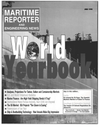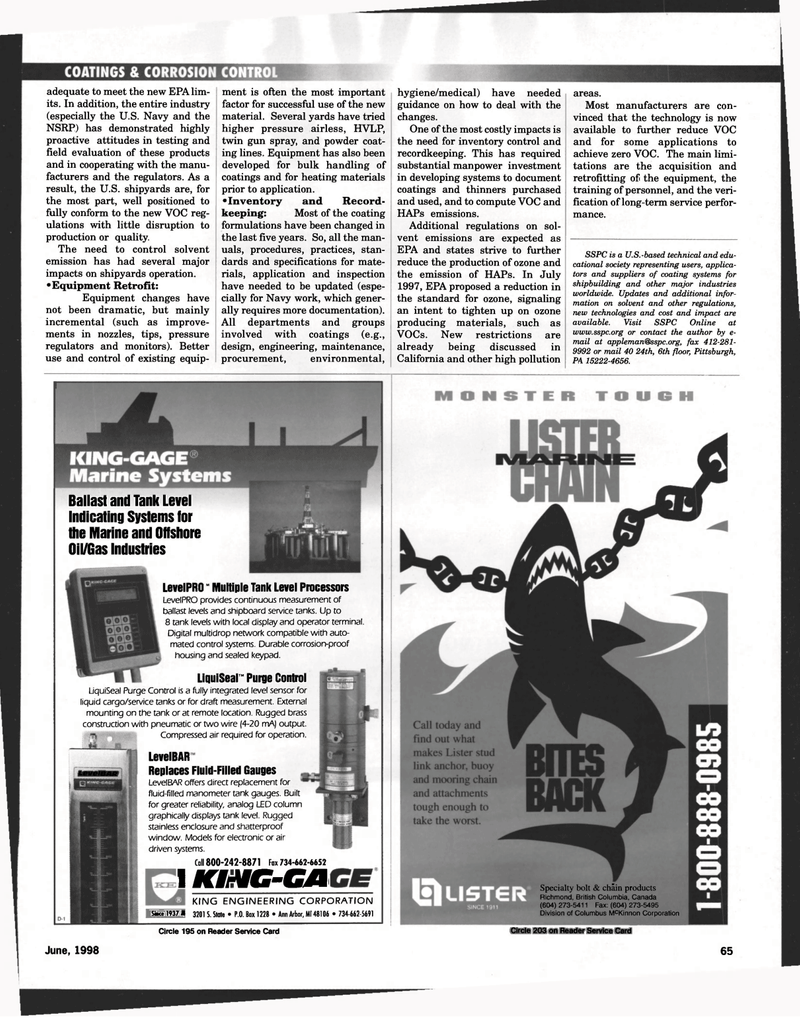
Page 76: of Maritime Reporter Magazine (June 1998)
Read this page in Pdf, Flash or Html5 edition of June 1998 Maritime Reporter Magazine
adequate to meet the new EPA lim- its. In addition, the entire industry (especially the U.S. Navy and the
NSRP) has demonstrated highly proactive attitudes in testing and field evaluation of these products and in cooperating with the manu- facturers and the regulators. As a result, the U.S. shipyards are, for the most part, well positioned to fully conform to the new VOC reg- ulations with little disruption to production or quality.
The need to control solvent emission has had several major impacts on shipyards operation. •Equipment Retrofit:
Equipment changes have not been dramatic, but mainly incremental (such as improve- ments in nozzles, tips, pressure regulators and monitors). Better use and control of existing equip- ment is often the most important factor for successful use of the new material. Several yards have tried higher pressure airless, HVLP, twin gun spray, and powder coat- ing lines. Equipment has also been developed for bulk handling of coatings and for heating materials prior to application. •Inventory and Record- keeping: Most of the coating formulations have been changed in the last five years. So, all the man- uals, procedures, practices, stan- dards and specifications for mate- rials, application and inspection have needed to be updated (espe- cially for Navy work, which gener- ally requires more documentation).
All departments and groups involved with coatings (e.g., design, engineering, maintenance, procurement, environmental, hygiene/medical) have needed guidance on how to deal with the changes.
One of the most costly impacts is the need for inventory control and recordkeeping. This has required substantial manpower investment in developing systems to document coatings and thinners purchased and used, and to compute VOC and
HAPs emissions.
Additional regulations on sol- vent emissions are expected as
EPA and states strive to further reduce the production of ozone and the emission of HAPs. In July 1997, EPA proposed a reduction in the standard for ozone, signaling an intent to tighten up on ozone producing materials, such as
VOCs. New restrictions are already being discussed in
California and other high pollution areas.
Most manufacturers are con- vinced that the technology is now available to further reduce VOC and for some applications to achieve zero VOC. The main limi- tations are the acquisition and retrofitting of the equipment, the training of personnel, and the veri- fication of long-term service perfor- mance.
SSPC is a U.S.-based technical and edu- cational society representing users, applica- tors and suppliers of coating systems for shipbuilding and other major industries worldwide. Updates and additional infor- mation on solvent and other regulations, new technologies and cost and impact are available. Visit SSPC Online at www.sspc.org or contact the author by e- mail at [email protected], fax 412-281- 9992 or mail 40 24th, 6th floor, Pittsburgh,
PA 15222-4656. r Specialty bolt & chain products
Richmond, British Columbia, Canada (604) 273-5411 Fax: (604) 273-5495
Division of Columbus McKinnon Corporation
Circle 203 on Reader Service Card l
Ballast and Tank Level
Indicating Systems for the Marine and Offshore
Oil/Gas Industries
LeuelBMt
LevelBAR
Replaces Fluid-Filled Gauges
LevelBAR offers direct replacement for fluid-filled manometer tank gauges. Built for greater reliability, analog LED column graphically displays tank level. Rugged stainless enclosure and shatterproof window. Models for electronic or air driven systems.
Coll 800-242-8871 Fax 734-662-6652
KINO-GAGE
KING ENGINEERING CORPORATION •IH93H 3201 S. State • P.O. Box 1228 • Ann Arbor, Ml 48106 • 734-662-5691
Circle 195 on Reader Service Card
LevelPRO" Multiple Tank Level Processors
LevelPRO provides continuous measurement of ballast levels and shipboard service tanks. Up to 8 tank levels with local display and operator terminal.
Digital multidrop network compatible with auto- mated control systems. Durable corrosion-proof housing and sealed keypad.
LiquiSeal " Purge Control
UquiSeal Purge Control is a fully integrated level sensor for liquid cargo/service tanks or for draft measurement. External mounting on the tank or at remote location. Rugged brass construction with pneumatic or two wire (4-20 mA) output.
Compressed air required for operation.
June, 1998 65

 75
75

 77
77
